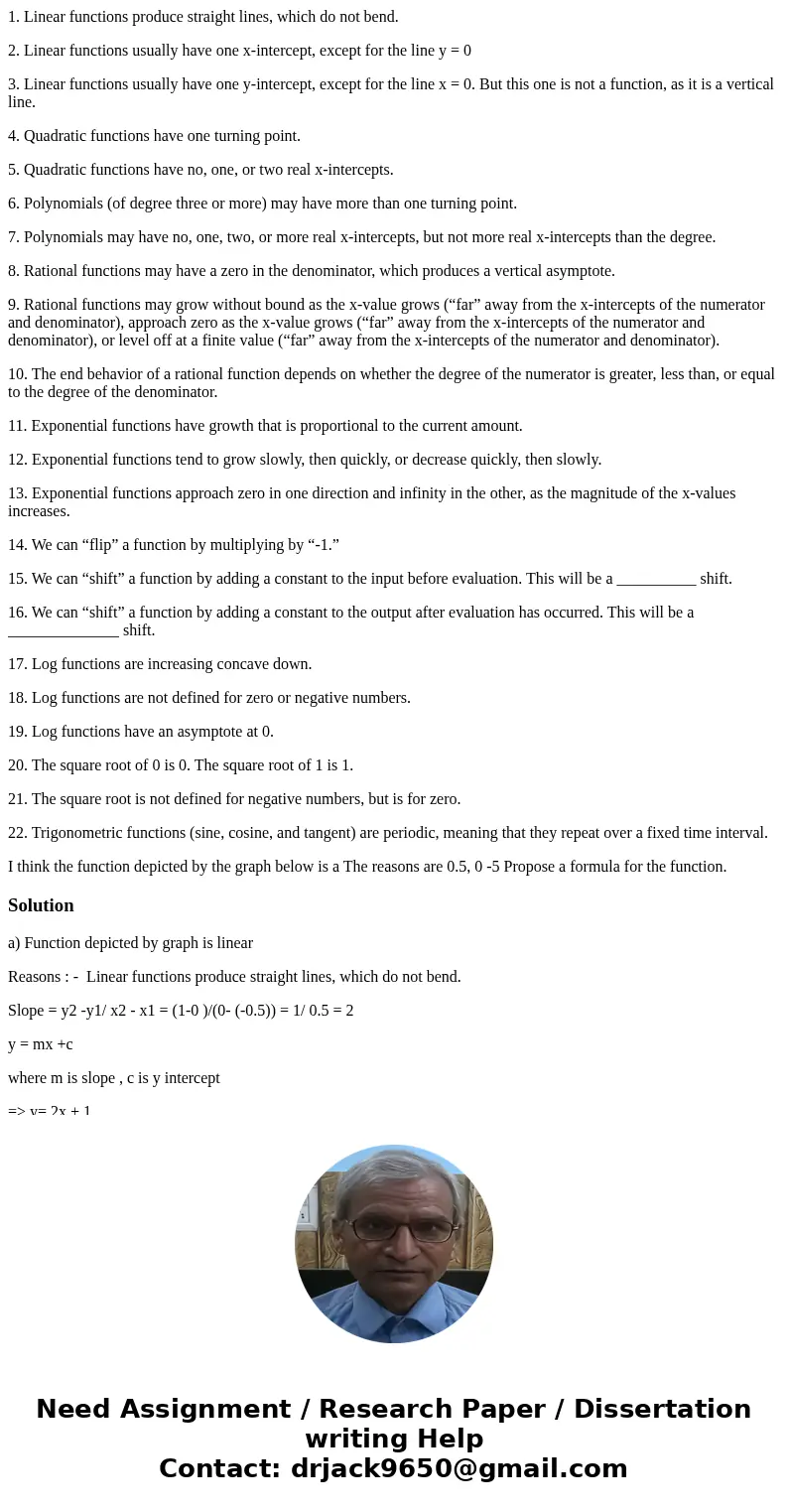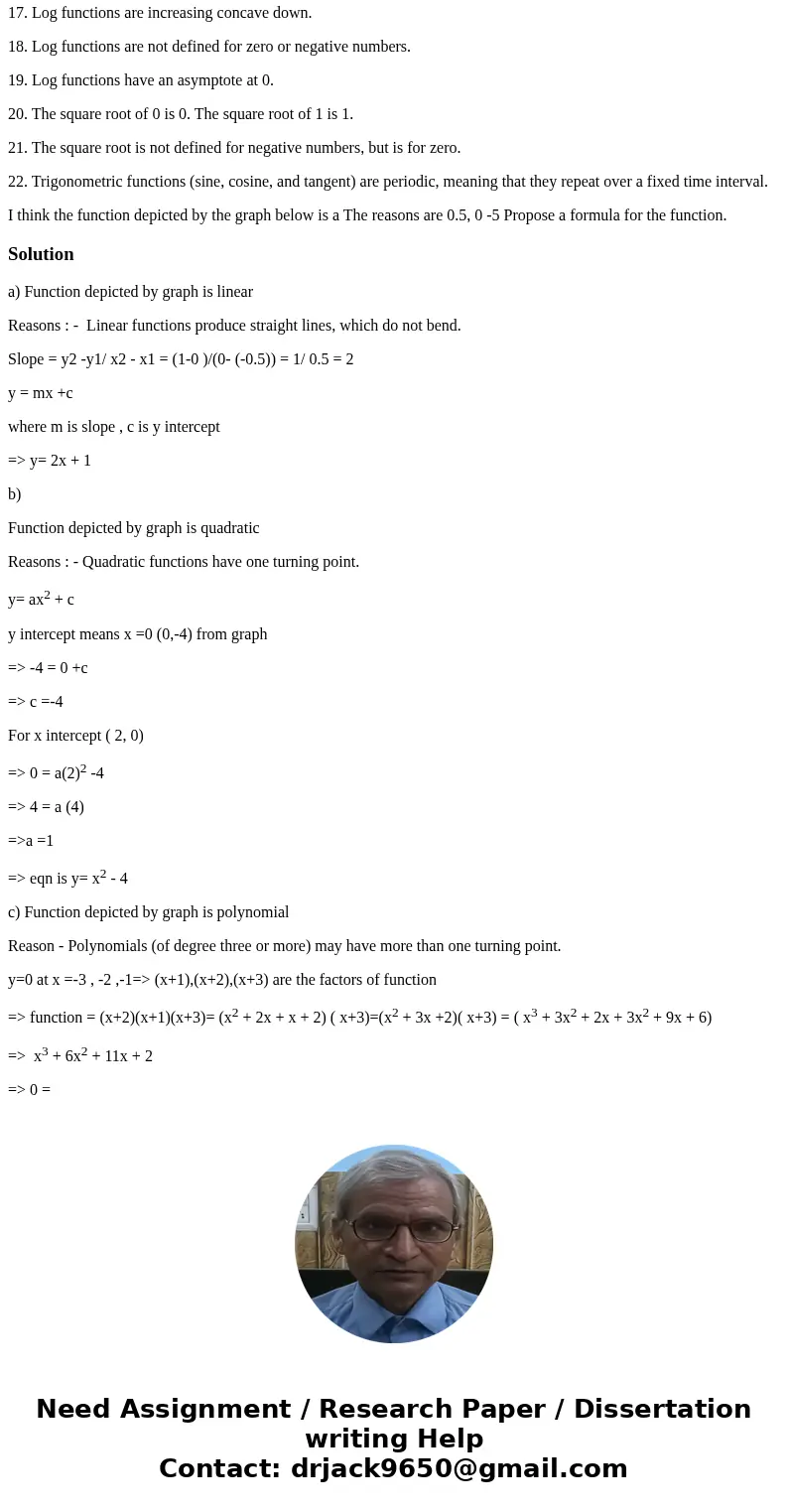1 Linear functions produce straight lines which do not bend
1. Linear functions produce straight lines, which do not bend.
2. Linear functions usually have one x-intercept, except for the line y = 0
3. Linear functions usually have one y-intercept, except for the line x = 0. But this one is not a function, as it is a vertical line.
4. Quadratic functions have one turning point.
5. Quadratic functions have no, one, or two real x-intercepts.
6. Polynomials (of degree three or more) may have more than one turning point.
7. Polynomials may have no, one, two, or more real x-intercepts, but not more real x-intercepts than the degree.
8. Rational functions may have a zero in the denominator, which produces a vertical asymptote.
9. Rational functions may grow without bound as the x-value grows (“far” away from the x-intercepts of the numerator and denominator), approach zero as the x-value grows (“far” away from the x-intercepts of the numerator and denominator), or level off at a finite value (“far” away from the x-intercepts of the numerator and denominator).
10. The end behavior of a rational function depends on whether the degree of the numerator is greater, less than, or equal to the degree of the denominator.
11. Exponential functions have growth that is proportional to the current amount.
12. Exponential functions tend to grow slowly, then quickly, or decrease quickly, then slowly.
13. Exponential functions approach zero in one direction and infinity in the other, as the magnitude of the x-values increases.
14. We can “flip” a function by multiplying by “-1.”
15. We can “shift” a function by adding a constant to the input before evaluation. This will be a __________ shift.
16. We can “shift” a function by adding a constant to the output after evaluation has occurred. This will be a ______________ shift.
17. Log functions are increasing concave down.
18. Log functions are not defined for zero or negative numbers.
19. Log functions have an asymptote at 0.
20. The square root of 0 is 0. The square root of 1 is 1.
21. The square root is not defined for negative numbers, but is for zero.
22. Trigonometric functions (sine, cosine, and tangent) are periodic, meaning that they repeat over a fixed time interval.
I think the function depicted by the graph below is a The reasons are 0.5, 0 -5 Propose a formula for the function.Solution
a) Function depicted by graph is linear
Reasons : - Linear functions produce straight lines, which do not bend.
Slope = y2 -y1/ x2 - x1 = (1-0 )/(0- (-0.5)) = 1/ 0.5 = 2
y = mx +c
where m is slope , c is y intercept
=> y= 2x + 1
b)
Function depicted by graph is quadratic
Reasons : - Quadratic functions have one turning point.
y= ax2 + c
y intercept means x =0 (0,-4) from graph
=> -4 = 0 +c
=> c =-4
For x intercept ( 2, 0)
=> 0 = a(2)2 -4
=> 4 = a (4)
=>a =1
=> eqn is y= x2 - 4
c) Function depicted by graph is polynomial
Reason - Polynomials (of degree three or more) may have more than one turning point.
y=0 at x =-3 , -2 ,-1=> (x+1),(x+2),(x+3) are the factors of function
=> function = (x+2)(x+1)(x+3)= (x2 + 2x + x + 2) ( x+3)=(x2 + 3x +2)( x+3) = ( x3 + 3x2 + 2x + 3x2 + 9x + 6)
=> x3 + 6x2 + 11x + 2
=> 0 =


 Homework Sourse
Homework Sourse